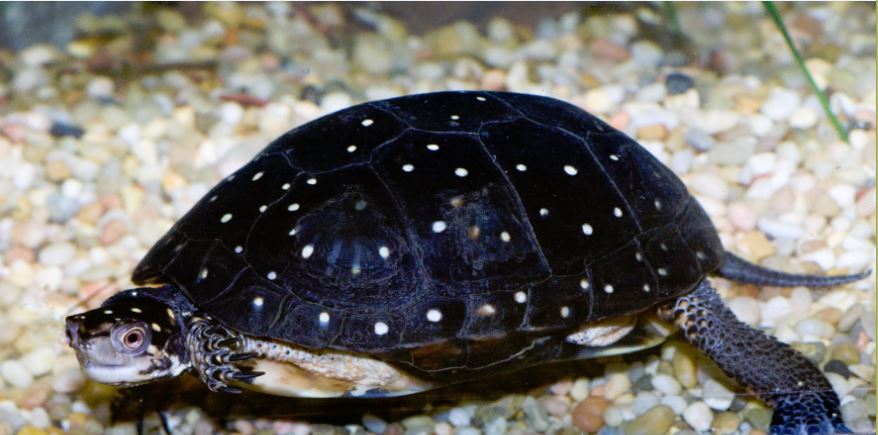

Reptile
Location at the Zoo
Americas
Region
North America
Spotted turtle
Clemmys guttata
Spotted turtles have a dull, black or brown, smooth, oval carapace which is keelless, unserrated and dotted with bright yellow or orange spots which differ in intensity and size. The plastron is yellow or orange with black patches which increase with age. Their head, legs and tail are dark grey or black with yellow spots; the tail may have yellow streaks. The undersides of the limbs and neck are pink to salmon coloured. The feet [five toes on the front and four toes on the back] are only slightly webbed. Sexual dimorphism is present in this species with the females having orange irises, orange to bone coloured chins, flat plastrons and thin tails with the cloaca located close to the body whereas the males have brown to buff irises and chins, concave plastrons and thicker tails with the cloaca located closer to the tip.
Length: 8 - 13cm.
Conservation Status: IUCN

Distribution
This turtle is found in isolated communities in southern Ontario around Georgian Bay, Lake Erie and some scattered in Algonquin Park, Kawartha Lakes and Ottawa areas. They have not been seen in Quebec for two decades. They are also located along the eastern seaboard of the U.S.A from Maine south to central Florida and near the great lakes in Pennsylvania, Ohio, southern Michigan, Indiana.Habitat
They prefer marshy meadows, swamps, bogs, small ponds, shallows of lakes, cypress swamps, Carolina bays and brackish waters of tidal streams, all of which have soft bottoms.Diet
These omnivores include in their diet aquatic insects, slugs, snails, crustaceans, tadpoles, dead fish, algae, and aquatic vegetation including cranberries.Reproduction
Spotted turtles are sexually mature between the ages of seven to fifteen years of age. Courtship, which occurs soon after emerging from hibernation, involves the males actively chasing a female on land and in the water often lasting 20 minutes, biting at her tail and hind legs until he mounts her in shallow water. Multiple males may fight with each other by biting until one is victorious. All this activity usually occurs in the afternoon in late May to early June. Later in June, the females migrate across the land looking for well drained, sandy or soft soil in a sunny location or deep leaf litter in a forested area. After she digs the nest with her hind legs as deep as she can reach, a clutch of two to seven white, elliptical eggs are laid at night. She fills in the nest and smoothes the site with her plastron so it is not visible. Although in the northern range of this turtle, a clutch may not be laid every year, in the southern part of its range three clutches may be laid annually. The females may store the sperm for up to four years, a lot longer than most other reptiles, an adaptation which makes it unnecessary for her to find a mate in the spring. Moreover, if the winter has been particularly harsh resulting in death of some turtles during hibernation this ability promotes the species survival.The incubation period is 73 -83 days with faster development at higher temperatures. The young hatch at night in August or September and usually bury themselves in nearby soil or debris but have been known to overwinter in the nest so they grow more in their first year because they have a longer first growing season. The hatchlings, about three cm long have one yellow spot per scute, but occasionally, no spots are visible. The sex of the hatchlings is dependent on the temperature of the eggs in the nest. The females are slightly larger than the males. Spotted turtles may live 70 to 90 years.
Adaptation
Spotted turtles are diurnal but prefer cooler temperatures so that they are most active all day in April for example, but as the season warms they are active in early morning and late afternoon. During the heat of the summer, they hide in the mud at the bottom of ponds to keep cool or move to cooler water. Sometimes they bury themselves on land waiting for autumn rains, then move back to the water. Although they may aestivate in their southern range during the heat of the summer, in Ontario, they remain dormant. Aestivation is the summer equivalent of hibernation, greatly reduced activity for the season whereas dormant is being inactive or asleep for a much shorter period of time. During cooler temperatures they are seen basking on shore or deadheads using the sun to warm up but when disturbed they submerge themselves on the bottom under mud or debris. Each night, alone or with other spotted turtles, they burrow into the muddy wetland bottom and remain inactive until the morning. Sometimes they take refuge in mammal burrows, such as muskrats’. They hibernate in these or bury in the bottoms of wetlands from late October until February or April.These turtles spend time on land as well as in the water but if threatened, they are able to withdraw their limbs and head into the shell for some protection.
Threats to Survival
Loss of habitat because ponds and wetlands are drained for developments and to increase arable farmland. Many spotted turtle populations are fragmented, separated by roads and developments which results in less genetic variation.Polluted ponds and wetlands resulting from road and farm runoff also effects these turtles. Studied populations reveal a low proportion of juveniles which means that the adults are having low reproductive success or the eggs and young are predated by raccoons, skunks, foxes, muskrats, snapping turtles, and dogs.
These turtles with their spotted carapace and small size have been very popular as pets.